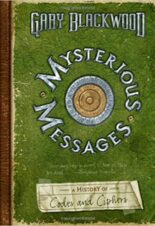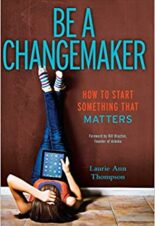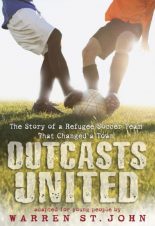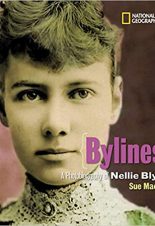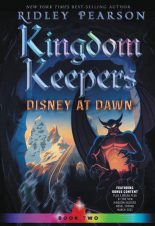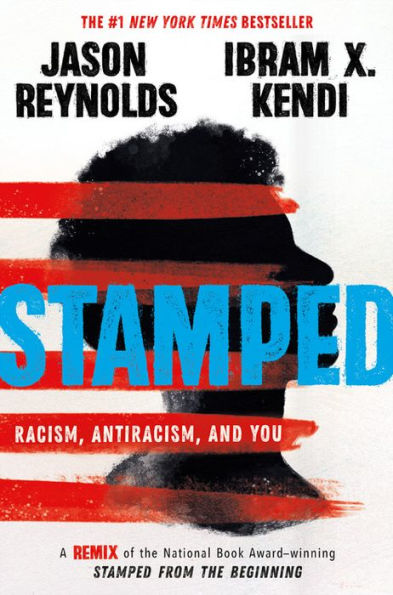
Buy This Book Buy This Series
“And an antiracist America is sure to come. No power lasts forever. . . There will come a time when we will love humanity, when we will gain the courage to fight for an equitable society for our beloved humanity, knowing, intelligently, that when we fight for humanity, we are fighting for ourselves,” Ibram X. Kendi. —Stamped
Stamped: Racism, Antiracism, and You
by Jason Reynolds & Ibram X. Kendi
AR Test
13+
Score
6.5
320
Written originally as Stamped from the Beginning by Ibram X. Kendi, Stamped: Racism, Antiracism, and You is the exploration of racism in the United States since before the founding of America. The book is remixed for younger audiences by prolific author and the Library of Congress’s National Ambassador for Young People’s Literature, Jason Reynolds. The fast-paced book explores the history of racism and how we can build an antiracist present and future.
Reynolds makes it clear that Stamped is not a history book, but instead a book about racism in present times. Although there is plenty of history described, he pulls the essentials from Kendi’s book and brings these historical events and people to life for younger readers. He shows how racist thoughts have persisted through time and affect everyone today. Most importantly, he uses Kendi’s definitions of segregationists, assimilationists, and antiracists to explore various thoughts about race, race relations, and racist ideas.
Reynolds breaks down the three terms by saying, “The antiracists try to transform racism. The assimilationists try to transform Black people. The segregationists try to get away from Black people.” Reynolds’ ability to bring difficult topics to a level that young teens can understand is remarkable, as racism is so prevalent and widespread across the United States and the world.
Despite Reynolds’ sense of humor and smooth-flowing writing, Stamped is not a cheery book, nor is it supposed to be. The history of racism is terrible; terrible things have happened and still happen – a point which Reynolds and Kendi make throughout. There is are discussions about mass incarceration, lynching, slavery, and kidnapping – all of which pertain to the history of racism. They also analyze major players in the Civil Rights movement, some of which fall into the assimilationist category, and others into the antiracist category.
Racism exists, and Reynolds and Kendi ask that people become antiracist in thought and in practice. Hope is a strong thread that pulls the novel together, despite the atrocities committed because of racist beliefs and policies. If people can become antiracist, the future can be so much brighter for many people who have faced oppression. Everyone should read Stamped because it isn’t a history book; it’s a guide to a better way of being and treating people.
Sexual Content
- Reynolds breaks down a scene from the book of Genesis in the Bible, discussing how Noah orders his “white sons not to have sex with their wives on the ark, and then tells them that the first child born after the flood would inherit the earth. When the evil, tyrannical, and hypersexual Ham has sex on the ark, God wills that Ham’s descendants will be dark and disgusting, and the whole world will look at them as symbols of trouble.”
- It was not uncommon for slave owners to start “breeding slaves. . . [Thomas Jefferson] and other like-minded slave owners began forcing their men and women slaves to conceive children so that they, the owners, could keep up with all the demands of the Deep South.”
Violence
- Reynolds and Kendi detail the racial violence that has occurred throughout history and in present times. They often discuss topics such as murder, slavery, and incarceration, as well as a host of other atrocities. For instance, “Young Black males were twenty-one times more likely to be killed by police than their White counterparts between 2010 and 2012, according to federal statistics.” Other details of violence are frequently shared throughout the book.
- Reynolds also discusses violence against Native Americans. For example, he talks about Metacomet, “a Native American war leader, [who] was killed, which basically ended the battle in 1676. Puritans cut up his body as if it were a hog’s, and paraded his remains around Plymouth.”
- Reynolds describes the movie The Birth of a Nation, where, “A Black man (played by a White man in blackface) tries to rape a White woman” who then “jumps off a cliff and kills herself,” and “Klansmen avenge her death.”
Drugs and Alcohol
- Reynolds writes about tobacco as a major cash crop in the American South prior to the founding of the country.
- There is a discussion about the “War on Drugs” and “crack babies” in their relation to racism and racist government policies.
Language
- Based on historical context, language is used to dehumanize Black people is scattered throughout the book. The language describes the growth and pervasiveness of racism. Reynolds, for instance, discusses the thoughts of Italian philosopher Lucilio Vanini, who said that “Africans were born of a ‘different Adam,’ and had a different creation story. Of course, this would mean they were a different species. It was kind of like saying that Africans weren’t actually human . . . Africans went from savages to SAVAGES, which revved up the necessity for Christian conversion and civilizing.”
- Racial slurs are used in historical context. For instance, Reynolds talks about a group of artists that emerged out of the Harlem Renaissance that referred to themselves as the “Niggerati. They believed they should be able to make whatever they wanted to express themselves as whole humans without worrying about White acceptance.”
Supernatural
- Reynolds describes Curse Theory, saying, “In 1577, after noticing that Inuit people in northeastern Canada were darker than the people living in the hotter south, English travel writer George Best determined . . . that it couldn’t have been climate that made darker people inferior, and instead determined that Africans were, in fact, cursed . . . And what did Best use to prove this theory? Only one of the most irrefutable books of the time: the Bible.”
- Reynolds talks about witches and witchcraft. Reynolds writes, “[Cotton] Mather wrote a book called Memorable Providences, Relating to Witchcrafts and Possessions . . . Mather’s book, outlining the symptoms of witchcraft, reflected his crusade against the enemies of White souls.” This book launched the Salem witch hunt of 1692.
Spiritual Content
- Reynolds uses comparisons to make history digestible and sometimes includes religious descriptors. Gomes Eanes de Zurara wrote propaganda for Prince Henry to encourage the slave trade. For instance, Zurara “made Prince Henry out to be some kind of youth minister canvassing the street, doing community work, when what Prince Henry really was, was more of a gangster.”
- Reynolds describes the links between racism and Christianity, and many times the Bible is referenced. For instance, at one point Reynolds says, “Zurara’s documentation of the racist idea that Africans needed slavery in order to be fed and taught Jesus, and that it was all ordained by God, began to seep in and stick to the European cultural psyche.”
- Reynolds discusses Puritans. He says, “They were English Protestants who believed the reformation of the Church of England was basically watering down Christianity, and they sought to regulate it to keep it more disciplined and rigid.”
by Alli Kestler
“And an antiracist America is sure to come. No power lasts forever. . . There will come a time when we will love humanity, when we will gain the courage to fight for an equitable society for our beloved humanity, knowing, intelligently, that when we fight for humanity, we are fighting for ourselves,” Ibram X. Kendi. —Stamped
Latest Reviews

Friends Fur-Ever

Harry Houdini: A Magical Life

The Greedy Gremlin

Hoop Genius: How a Desperate Teacher and a Rowdy Gym Class Invented Basketball

Our Violent Ends

Healer of the Water Monster

Lost in the Mushroom Maze

Sticks and Stones

Jasmine Toguchi, Super Sleuth

